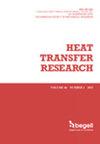斯托克斯流的强制对流换热,包括任意波纹通道中的粘性耗散
IF 1.6
4区 工程技术
Q3 THERMODYNAMICS
引用次数: 0
摘要
采用渐近方法和数值方法研究了斯托克斯流的强迫对流换热问题,其中包括任意波纹通道中的粘性耗散。目的是指定形状参数的范围,以确保渐近方法的有效性,特别是关于传热的特性。轴向速度,横向速度,压力和温度,对于小波纹的斜率与统一,被寻求作为一个渐进展开的参数,表示波纹的斜率。利用ANSYS Fluent求解器进行了数值求解。此外,还集成了Python脚本来自动化模拟的几个部分,包括几何图形的创建和参数化研究。研究了三种不同类型的波纹,包括之字形,正弦和任意波纹,使用由傅里叶级数的特定情况给出的函数定义。计算努塞尔数来评估对流换热。结果表明,小波状边坡的渐近解和数值解符合得很好,数量上的差异可以忽略不计。然而,随着波纹的斜率增加(接近于一致),这些数量上的差异会增加,直到观察到局部努塞尔数的行为发生变化。结果表明,由于平均流速的减小,在具有发散壁面的通道区域局部努塞尔数减小。相比之下,由于平均速度的增加,在具有收敛壁面的通道区域,它会增加。本文章由计算机程序翻译,如有差异,请以英文原文为准。
Forced convective heat transfer for Stokes flow including viscous dissipation in arbitrary corrugated channels
The forced convective heat transfer for Stokes flow, including viscous dissipation in arbitrary corrugated channels, is studied using both an asymptotic method and a numerical solution. The aim is to specify the range of shape parameters for which the validity of the asymptotic approach is ensured, particularly regarding the characteristics of heat transfer. The axial velocity, transversal velocity, pressure, and temperature, for small corrugation's slope compared with unity, are sought as an asymptotic expansion in terms of a parameter that represents the corrugation's slope. The numerical solution is obtained by using ANSYS Fluent solver. Additionally, Python scripting is integrated to automate several parts of the simulations, including the creation of the geometry and a parametric study. Three different types of corrugations are investigated including zigzag, sinusoidal, and arbitrary corrugations defined using a function given by a particular case of the Fourier series. The Nusselt number is calculated to evaluate convective heat transfer. It is found that the asymptotic and numerical solutions for small corrugation's slope, are in good agreement with negligible quantitative differences. However, as the corrugation's slope increases (approaches unity), these quantitative differences increase up to cases where a change in the behavior of the local Nusselt number is observed. The results show that the local Nusselt number decreases in the channel's region with divergent walls due to the decrease in the average velocity. In contrast, it increases in the channel's region with convergent walls due to the increase in the average velocity.
求助全文
通过发布文献求助,成功后即可免费获取论文全文。
去求助
来源期刊

Heat Transfer Research
工程技术-热力学
CiteScore
3.10
自引率
23.50%
发文量
102
审稿时长
13.2 months
期刊介绍:
Heat Transfer Research (ISSN1064-2285) presents archived theoretical, applied, and experimental papers selected globally. Selected papers from technical conference proceedings and academic laboratory reports are also published. Papers are selected and reviewed by a group of expert associate editors, guided by a distinguished advisory board, and represent the best of current work in the field. Heat Transfer Research is published under an exclusive license to Begell House, Inc., in full compliance with the International Copyright Convention. Subjects covered in Heat Transfer Research encompass the entire field of heat transfer and relevant areas of fluid dynamics, including conduction, convection and radiation, phase change phenomena including boiling and solidification, heat exchanger design and testing, heat transfer in nuclear reactors, mass transfer, geothermal heat recovery, multi-scale heat transfer, heat and mass transfer in alternative energy systems, and thermophysical properties of materials.
 求助内容:
求助内容: 应助结果提醒方式:
应助结果提醒方式:


